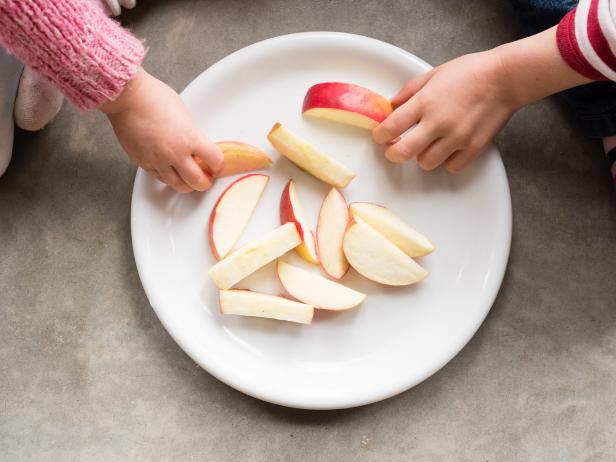What Parents Need to Know About the AAP’s New Weight Loss Guidelines for Kids
We asked registered dieticians to break down the American Academy of Pediatrics’ recently released guidelines, which are the first of their kind in 15 years.

Natalie Board / EyeEm/Getty Images
In early 2023, the American Academy of Pediatrics (AAP) released new weight loss guidelines pertaining to children and adolescents. As a parent, it is certainly tough to get your child through a period where weight loss is recommended by a medical doctor. If a child is considered overweight or obese, and intervention is recommended by a qualified health professional, it is important for parents, together with their child, to seek help from a healthcare team. Effective treatment is critical, as being overweight or obese can lead to serious physical health conditions in the immediate future.
However, when navigating diagnosis and treatment, it’s equally important to properly manage discussions and approaches to weight loss. Parents and healthcare professionals must discuss these issues with care. Failure to do so can lead to mental health and body image issues — in fact, activists like Aubrey Gordon, also known Your Fat Friend, have spoken out, worried the new guidelines could heavily encourage disordered eating and don’t properly address the culture of weight stigma. As such, it’s important for parents to be equipped with as much information as possible, especially when seeking out the right healthcare professional and treatment for their child.
The new guidelines state specific recommendations for healthcare practitioners to determine whether a child is considered above a normal weight for their age. If so, then the AAP guidelines recommend early intervention and how often the child and parents should consult with their healthcare team (including a registered dietitian nutritionist). Below is a look at the new AAP children and adolescent weight loss guidelines, how to best navigate treatment and what parents need to know through the process.
Who Are These Guidelines For?
According to the Centers for Disease Control and Prevention (CDC), obesity is a serious problem in the U.S. and affects one in five children and adolescents. Obesity-related physical health conditions include high blood pressure, high cholesterol, type 2 diabetes, joint problems and breathing issues (like asthma and sleep apnea). As such, the AAP’s new guidance on childhood obesity is encouraging practitioners to offer treatment options early on, and see the child (and their caregivers) frequently, in order to help mitigate health problems.
How Is Obesity Defined in Children and Teens?
The measurement for obesity and being overweight in children and adolescence is based on a measurement called body mass index (BMI). BMI is calculated by dividing weight in kilograms by the square of height in meters. For children and teenagers, BMI interpretations are based on age and gender percentiles with a BMI at or above the 85th percentile and below the 95th percentile being overweight, and at or above the 95th percentile being obese.
During adolescence and puberty, some weight gain is expected — and normal. Your child’s healthcare team will discuss with you, the parent, when it is appropriate to have weight loss interventions.
Are the New AAP Weight Loss Guidelines for Kids and Adolescents Too Extreme?
Jill Castle, MS, RD, founder of The Nourished Child, and author of upcoming book Size Wise (Workman), weighed in on the new AAP guidelines saying, “As the guidelines read, they’re meant to offer options with increasing intensity for those who are larger and whose health has been compromised. However, the most intensive treatments – use of medications and bariatric surgery – for children over 12, are long-term treatments, one of which is a permanent change (bariatric surgery). As these have been around but not widely implemented, we don't know the long-term efficacy or physical and mental health outcomes yet.”
Prior to the release of these guidelines, Castle also explains that there has generally been a “wait and see” approach. The new guidelines are significant because they promote immediate action at the earliest possible time, with more aggressive action for children whose lifestyle interventions aren’t working or who classify at higher stages (2 or 3) of obesity.
What To Expect at A Visit
Castle weighed in on what she hopes a family would encounter during a visit with a registered dietitian nutritionist (RDN), which is “behavior-focused care centered on helping children and families adopt enjoyable lifestyle behaviors that improve physical health and emotional well-being rather than a weight-centric approach that is focused on weight loss.” In addition, Castle explains that weight loss is very difficult to achieve as obesity is a disease that doesn’t easily relent with weight loss efforts, at least in the long term. That’s why more aggressive treatment options are now being recommended in conjunction with lifestyle changes.
If a child is placed on a restrictive diet to lose weight, it can put them at risk for weight cycling (repeatedly gaining and losing weight throughout their lives) and emotional consequences like poor self-worth and depression, which can last into adulthood. In addition, it could also lead to disordered eating. That is why choosing the right healthcare team is important.
During an initial visit, the RDN will gather information, including any health conditions, sleep habits, exercise habits and eating patterns (including meals and snacks). They will also look at your child’s blood work, which should be ordered by your pediatrician. Every RDN has their own approach, but as Castle mentions above, the most important thing to focus on is behavior changes so that healthier habits can be promoted, and a healthier weight will follow.
How to Choose the Right Doctors to Work with You and Your Child
Castle recommends looking for “doctors who see the big picture, are compassionate and who are weight-neutral (not biased against individuals of larger size).” Castle also recommends looking for inclusive furniture in the office that is designed for children of all sizes, private measuring of growth parameters and a professional who is tuned into the reason you are there and doesn’t jump to talking about weight, losing weight and a child’s health related to weight. In addition, terms related to the disease of obesity can be stigmatizing. So, Castle recommends listening for stigmatizing language from anyone in the office, like “obese person,” which may give you a clue about their bias.
How to Speak to Your Child or Teen About Weight
When discussing the body with your child, it’s important to be sensitive to protect your child’s mental wellbeing. Childhood and adolescence are when eating disorders and disordered eating behaviors can begin to form. The Academy of Nutrition and Dietetics provides the following recommendations when discussing weight with your child:
Encourage an Open Dialogue: When speaking with your child about weight, encourage them to share their thoughts and feelings about body image when they arise. Listen to your child and acknowledge that their feelings are real.
Don’t Make Negative Comments: Judging your own body or your child’s body can result in lasting detrimental effects to your child’s body image and relationship with food. Role model positive talk about your body.
Take Action: Encourage habits that can help keep your child healthy throughout their life. This includes serving regular, balanced meals.
Don’t Play the Blame Game: Never yell, scream, bribe, threaten or punish kids about their weight, food or exercise habits. The worse a child feels about their weight, the more likely they will develop an unhealthy relationship with food.
Keep a United Front: Encourage both parents and important friends and relatives to be on the same page and provide support with positive messages. Mixed messages about weight can lead to unhealthy consequences.
Talk to an RDN: If you’re concerned about your child’s weight, speak to a registered dietitian nutritionist (RDN) who can help guide you through treatment. There are also RDNs who specialize in child and teen body image and having a positive relationship with food. Check the RDN’s website or call and ask about their philosophy to help make sure you choose the right RDN for your child.
Resources Are Available
For many families, getting access to the appropriate resources can be difficult. Knowing what is available is half the battle. “In our current economic conditions, with rising costs of groceries and gas prices, everyone is either concerned about their tight food budget or struggling to purchase the most nourishing items. Affordable, nutritious options are at grocery stores and other retail locations like dollar stores and corner stores. Think frozen or canned food! Low-sodium and low-sugar canned fruits, vegetables, and meats ready-to-eat are packed with nutrition,” says Clancy Harrison, MS, RDN, LDN who is a nationally-renowned keynote and TEDx speaker, food equity advocate, founder of the Food Dignity Movement, television and media contributor, host of The Food Dignity Podcast and registered dietitian.
“Families can also access free or reduced breakfast and lunch at their local school district during the school year and at summer camps. Call the U.S. Department of Agriculture (USDA) Hunger Hotline at 1-866-348-6479 or 1-877-842-6273 for Spanish. No Kid Hungry also offers an interactive map that allows caregivers to search for free food by breakfast, lunch, afternoon snack and supper. The website is here. School meal and summer meal programs must comply with strict nutritional guidelines to maintain funding,” says Harrison.
If calling isn’t your thing, Amanda Frankeny RDN, LDN is Program Director and Agricultural Strategist at the Food Dignity Movement. Frankeny is also a registered dietitian who provides information for a texting service from the USDA’s Hunger Hotline at 914-342-7744. “Automated texts detailing everything about the USDA feeding services will be provided to you. Just type in these keywords: ‘SNAP’ will get you more information on Supplemental Nutrition Assistance Program, one of the government food purchasing supports for families across the U.S. Type ‘EBT’ for Electronic Benefits Transfer or payment details associated with SNAP purchases. Text ‘School Meals’ for more information on free or reduced school food for your kids. Write ‘SFSP’ for Summer Food Service Program information focused on getting kids fed when school is out. Then, text ‘Food’ to find feeding resources in your particular area.”
Technology has created opportunities to find nourishing food at a discounted rate as well. Harrison provided several apps to help consumers connect to healthy options and reduce food waste at the same time:
- Too Good to Go: Enter your location information, and find food that is discounted and in need of rescue.
- Olio: Connect with neighbors to trade food and other household items.
- Flashfood and Food For All: As a food vendor or restaurant, the app allows people to buy foods at a discount that would normally be thrown away at the end of the day.
In terms of insurance coverage, Harrison explains that Children’s Health Insurance Program (CHIP) and Medicaid improve access to healthcare services for children living with obesity. The Early and Periodic Screening, Diagnostic and Treatment (EPSDT) benefit covers all medically necessary services. In addition, many insurance companies now cover medical nutrition therapy for children, but caregivers should confirm their coverage by calling the number on the back of their insurance card.
Additional services, Harrison says, are available for people who cannot afford it include the Supplemental Nutrition Assistance Program for Women Infant and Children (WIC), Supplemental Nutrition Assistance Program Education (SNAP-Ed), Farms Market Nutrition Programs which often centers nutrition educators at markets, food as medicine and other community outreach programs through local healthcare networks, virtual and in-person counseling and classes led by supermarket dietitians (where the cost of the visit is often reimbursed by a store gift card) and Medicaid.
Bottom Line: The new AAP guidelines address the serious physical need to get early intervention in children and teens with obesity, and it is no easy feat. However, through the process, parents must be sure to work with healthcare professionals who will be mindful of handling treatment and discussions in a healthful way. Insensitive conversations can lead to mental health and body image issues, and eating disorders. The journey through treatment should emphasize both physical and mental wellbeing for long-term health.
Related Content:

































